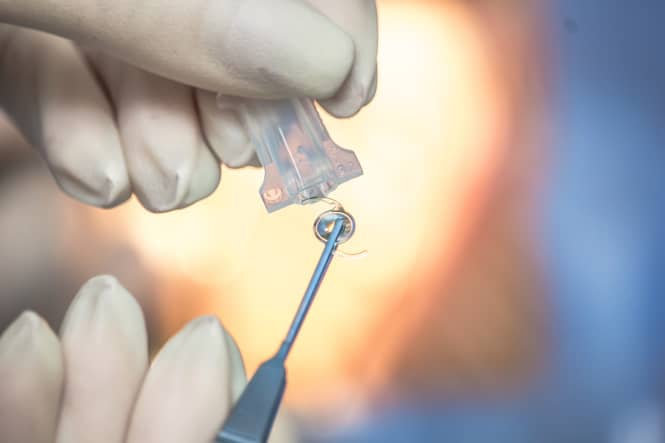Find Out If You Qualify for Phakic IOL Surgery in Overland Park, Kansas
Before committing to any laser vision correction procedure, you must first ensure that you’re comfortable with the process, understand the benefits and risks, and determine candidacy through an in-depth evaluation with a refractive eye surgeon.
Many people are familiar with the concepts of LASIK or cataract surgery, but there are far more options available for people like you who want to improve their vision and quality of life. One option is phakic IOL surgery, which involves implanting a contact lens under your cornea. This procedure is ideal for patients who are not LASIK candidates due to severe nearsightedness.
Keep reading to learn what you should know about this procedure before scheduling a consultation with Durrie Vision in Overland Park, Kansas, a recognized industry leader in refractive eye surgery.
Do You Qualify for Phakic IOL Surgery?
The preliminary qualification for phakic iol surgery is having nearsightedness with moderate to severe myopia. However, not everyone with nearsightedness will qualify for the procedure.
Candidates:
- Are between the ages of 21 and 45 years old.
- Have experienced no change in vision greater than .5 diopters in a year.
- Are not pregnant or nursing.
- Do not have moderate to severe optic nerve damage caused by glaucoma or other conditions.
A refractive eye surgeon will also verify whether your eye shape is appropriate for the procedure and that your endothelial cell density meets minimum requirements for your age. Only your refractive surgeon can determine whether you’re a candidate.
Why We Use EVO ICL at Durrie Vision
An EVO Implantable Collamer® Lens is a biocompatible, stable, flexible phakic IOL. It is the preferred lens we use at Durrie Vision due to its quality, comfort, and array of benefits for patients.
EVO ICL has been available internationally for more than a decade, with more than 2 million lenses distributed worldwide. A reliable product, the EVO ICL has achieved excellent clinical outcomes outside of the United States for years. We were pleased when it received the U.S. Food and Drug Administration’s approval in early 2022, giving our patients access to this incredible new vision correction technology for the first time in Kansas City.
What Happens During a Phakic IOL Procedure?
You will be awake during the procedure, which takes only 20 to 30 minutes total.
- Your refractive surgeon will dilate your pupils and apply a local anesthetic to your eyes.
- Your surgeon will create a small opening at the base of your cornea. This step is painless, thanks to the anesthetic. No corneal tissue is removed.
- Your surgeon will gently fold and insert the EVO phakic IOL through the incision and adjust it to ensure the proper positioning and fit.
- You can leave the office a short while after your procedure, as long as a friend or family member drives you home.
After your procedure, you’ll use prescription eye drops according to instructions from Dr. Stahl, your eye surgeon at Durrie Vision.
Phakic IOL Surgery Recovery
Like most refractive surgeries, recovery time for phakic IOLs is relatively short and simple, with your eyesight improving within a few days, and total recovery occurring within two months.
For the first seven days, avoid bending over or lifting heavy objects. Otherwise, you can resume most of your normal daily activities. For the first month, continue avoiding lifting heavy items and swimming in any body of water.
Benefits of Phakic IOL Surgery with the EVO ICL
Patients who have undergone a phakic IOL procedure with the EVO ICL report they enjoy sharp, clear vision without dry eye issues afterward – including those who have been told they don’t qualify for LASIK because their corneas are too thin.
The EVO ICL stands out because of these additional benefits:
- The new phakic IOL provides UV protection from the sun’s harmful rays.
- They require no maintenance and are designed to stay in place.
- They can be surgically removed in the future, if necessary. (However, if they are removed, patients no longer enjoy improved vision.)
- No one can tell they’re implanted, except your eye doctor.
Keep in mind that the EVO ICL only corrects distance vision and will not eliminate your need for reading glasses in the future.
How Much Do Phakic IOLs Cost?
Many people assume they can’t afford vision correction surgery – but considering that contact lenses can easily cost more than $12,000 during a single lifetime (or just over $5,000 in ten years), phakic IOLs can be affordable!
The cost of phakic IOLs, including the EVO ICL, will vary depending on a variety of factors. However, it is less expensive than purchasing traditional vision correction supplies for life. And because it is a fixed, one-time fee, you won’t have to repeatedly pay out of pocket.
Many patients are able to pay for their phakic IOLs through their health savings account (HSA), tax refund, or other short-term financing options.
Determine Your Candidacy for EVO ICL at Durrie Vision
If you’ve been told you aren’t eligible to receive LASIK vision correction in the past, you still may be a candidate for phakic IOLs. To find out, request an advanced ocular analysis from Durrie Vision today by calling us, texting us, or sending us a message online.

Author Bio: Jason E. Stahl, MD
Top Doctors: https://www.castleconnolly.com/top-doctors/jason-e-stahl-ophthalmology-129cc002150
Best Cataract Surgeons: https://bestcataractsurgeons.com/cataract-surgeons/jason-e-stahl/

